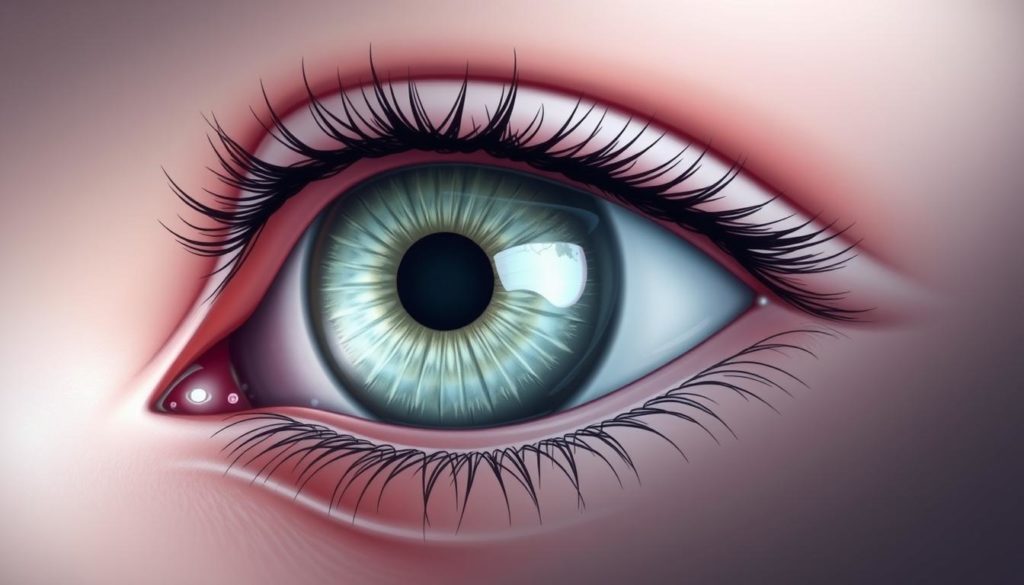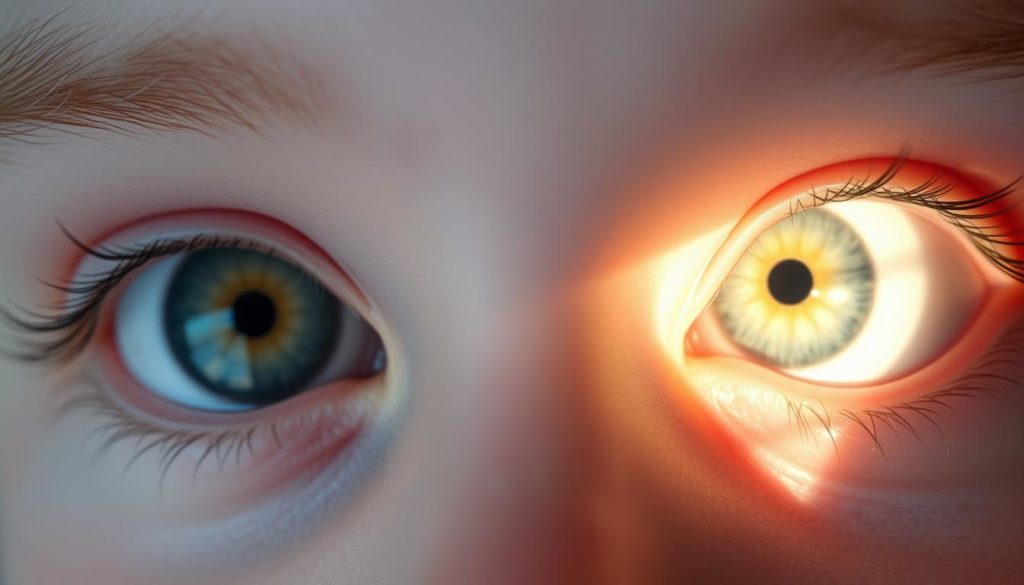“The eyes are the windows to the soul.” – William Shakespeare
Ocular albinism is a rare genetic condition that affects our vision. It’s different from albinism, which affects skin, hair, and eye color. Knowing about ocular albinism is key for those diagnosed and their families.
This article covers the basics of ocular albinism. Learning about it helps you understand and support those with this condition.
Introduction to Ocular Albinism
Ocular albinism is a genetic condition that mainly affects the eyes. It leads to poor vision, shaky eye movements, and light sensitivity. Unlike other albinisms, it mostly impacts the retina and optic nerves. Knowing the ocular albinism definition helps us understand its effects on vision and daily life.
What Is Ocular Albinism?
The ocular albinism definition refers to a genetic mutation causing less color in the iris and retina. This results in issues like nystagmus, poor depth perception, and light sensitivity. It’s usually passed down in an X-linked recessive pattern, affecting males more because they have only one X chromosome.

Types of Ocular Albinism
There are different types of ocular albinism, with Ocular Albinism Type 1 (OA1) being the most common. This type comes from mutations in the GPR143 gene. OA1 causes severe vision problems and underdeveloped retinas.
Other types are rarer but have their own genetic traits and vision impacts. The classification of ocular albinism also includes variations with other syndromes. This affects overall health and development.
Knowing the classification of ocular albinism aids in diagnosing and treating it. It allows for personalized medical care for those affected.
Symptoms of Ocular Albinism
It’s important to know the symptoms of ocular albinism early. This helps in managing the visual challenges it brings. We’ll look at the early signs, visual impairments, and complications like photophobia and nystagmus.

Early Signs
Spotting ocular albinism early is key. Look for signs in infants and toddlers. These include little to no pigmentation in the retina and odd eye movements.
Parents might also notice their kids are very sensitive to light.
Visual Impairments
People with ocular albinism face big visual challenges. They might have trouble seeing clearly and judging distances. Reading and recognizing faces can be hard.
They also struggle with seeing at night. This makes everyday tasks harder.
- Reduced visual acuity
- Poor depth perception
- Night vision challenges
Photophobia and Nystagmus
Photophobia and nystagmus are common in those with ocular albinism. Photophobia makes bright lights uncomfortable. Nystagmus causes eyes to move on their own, making it hard to focus.
This can lead to eye strain and fatigue.
| Symptom | Description |
|---|---|
| Photophobia | Increased sensitivity to light leading to discomfort in well-lit areas. |
| Nystagmus | Involuntary eye movements, making it difficult to focus on objects. |
| Visual Acuity | Reduced sharpness of vision, affecting the ability to see details. |
Causes of Ocular Albinism
Ocular albinism is caused by genetic mutations. These changes affect genes that help make melanin in the eyes. Melanin is key for eye cell growth, which helps us see.
When these genes don’t work right, it causes vision problems. This is what happens in ocular albinism.
The main cause is a GPR143 gene mutation on the X chromosome. This mostly affects males, as they have only one X chromosome. Females, with two X chromosomes, can carry the gene without showing symptoms.
This pattern of inheritance is important for understanding how the condition is passed down. It helps us see how it moves through families.
A study showed that these genetic changes affect eye development at different stages. It shows how complex and important these genetic factors are.
Genetic tests can show if someone carries these mutations. This is key for planning families and starting early treatments.
| Key Factor | Description |
|---|---|
| Genetic Mutations | Changes in the GPR143 gene disrupt melanin production in the eyes. |
| Inheritance Patterns | Follows X-linked recessive patterns, affecting males more severely. |
| Role in Eye Development | Essential for the proper development and functioning of retinal cells. |
Understanding ocular albinism means looking at these genetic changes and how they are passed down. This knowledge is crucial for those affected, researchers, and healthcare workers. It helps in finding treatments and ways to help.
Ocular Albinism Diagnosis
Diagnosing ocular albinism requires special techniques. These methods help doctors accurately spot the condition. This detailed process ensures patients get the right care.
Initial Eye Examination
The first step is a detailed eye check. An ophthalmologist uses a slit-lamp microscope to look at the eye. They look for any odd pigmentation in the iris and retina.
This check often shows light-colored or clear irises. These are signs of ocular albinism.
Genetic Testing
Genetic testing is key in diagnosing ocular albinism. It checks DNA for specific gene mutations. This test confirms the diagnosis and can show the type of albinism.
Labs use PCR and sequencing to find these genetic changes.
Advanced Diagnostic Tools
More advanced tools are used to confirm the diagnosis. Tools like OCT and FA give detailed retina images. They show where the condition affects the retina.
These tools help doctors make better treatment plans.
| Diagnostic Technique | Description | Purpose |
|---|---|---|
| Initial Eye Examination | Thorough inspection of the eye’s structure and pigmentation | Identify physical signs of ocular albinism |
| Genetic Testing | Analysis of DNA to detect genetic mutations | Provide genetic confirmation of the diagnosis |
| Optical Coherence Tomography | Imaging technique to visualize retinal layers | Assess retinal health and abnormalities |
Understanding the Genetics of Ocular Albinism
Ocular albinism is a complex genetic condition that mainly affects the eyes. It usually comes from mutations in specific genes.
The GPR143 gene, found on the X chromosome, plays a key role. Because of this, ocular albinism mostly affects males. Females, with two X chromosomes, are usually carriers and rarely show symptoms.
Knowing the genetic mutations behind this condition is key. Genetic research has shown that these mutations stop melanin production in the eyes. This leads to the symptoms of ocular albinism.
Scientists are working hard to understand these mutations better. This research could lead to new treatments. Genetic counseling is also important for families to understand their risks.
In short, studying ocular albinism’s genetics helps us understand its inheritance and how to treat it. It’s a vital area of study in genetic disorders.
Vision Problems Associated with Ocular Albinism
Vision problems linked to ocular albinism can be tough and really affect people’s daily lives. These issues can be mild or severe and need special ways to handle them.
Impact on Daily Life
Dealing with vision issues from ocular albinism can change many parts of daily life. For many, reading, driving, and exploring new places are hard. The lack of melanin in the eyes often means seeing things less clearly. This makes doing tasks that need sharp vision hard.
Also, glare and light sensitivity can make seeing even harder. This can really affect how people live their lives.
Treatment Options for Vision Problems
Even though there’s no cure for ocular albinism, there are treatments to help manage vision issues. These include:
- Corrective Lenses: Glasses or contact lenses can help see better and fix refraction problems.
- Surgical Interventions: Surgery might be needed to fix strabismus or nystagmus, which often come with ocular albinism.
- Vision Therapy: Special exercises and strategies can improve how well you see.
These treatments aim to make life better by improving vision. They help people deal with daily tasks and lessen the impact of ocular albinism vision problems.
What Is Ocular Albinism?
Ocular albinism is a rare genetic condition that mainly affects the eyes. It leads to poor vision. This happens because the retina and other parts of the eye don’t have enough melanin.
People with ocular albinism often have blurry vision, shaky eye movements, and are very sensitive to light. How much these problems affect someone can vary. Knowing about these vision issues is key for the right treatment.
This condition is passed down in an X-linked recessive pattern. This means it mostly hits males, but females can carry the gene and sometimes show mild symptoms. Studying the genetics helps us understand why and how ocular albinism happens.
Looking into ocular albinism shows how genetic changes affect the eye’s melanocytes. This leads to problems with seeing light and sharpness. Even though there’s no cure, learning about ocular albinism helps in finding ways to make life better for those with it.
| Characteristic | Description |
|---|---|
| Inheritance | X-linked recessive |
| Primary Symptom | Reduced vision acuity |
| Secondary Symptoms | Nystagmus, photophobia |
| Gender Prevalence | Mostly males |
In short, ocular albinism is a complex vision disorder. It needs a detailed approach for diagnosis and care. Through genetics or teaching patients, we can improve their lives and futures.
Treatment for Ocular Albinism
Dealing with ocular albinism needs a mix of treatments. This part looks at therapy options like medical care, vision therapy, and visual aid devices.
Medical Treatment Approaches
Medical care for ocular albinism focuses on visual problems. Doctors use glasses to correct vision and special glasses to reduce eye sensitivity. It’s important to talk to a doctor to find the best treatment for ocular albinism.
Vision Therapy
Vision therapy can help improve vision in ocular albinism. It’s a personalized program that can help kids a lot. It includes eye exercises and training to improve vision skills.
Low Vision Aids
Visual aid devices can make life easier for those with ocular albinism. These include magnifying glasses, electronic readers, and special computer software. They help with tasks that need clear vision.
- Handheld magnifiers for reading fine print
- Telescopic lenses for improved distance vision
- Electronic devices that convert text to speech
Living with Ocular Albinism
Living with ocular albinism has its own set of challenges. But, having a strong support system can really help. People with this condition find comfort and help through different resources. They also learn adaptive skills that meet their needs.
Support Systems and Resources
Community groups and organizations like the National Organization for Albinism and Hypopigmentation (NOAH) are key. They offer educational materials, connections to experts, and support from peers. Family and friends also play a big role, offering emotional support and boosting confidence.
“Joining a support group changed my perspective. I learned so many adaptive skills and met others who truly understand my experiences.”—A member of NOAH
Adaptive Techniques
Adaptive techniques are vital for those with ocular albinism. Magnifying glasses and screen-reader technology help with reading and using digital devices. Special training programs can cover mobility and educational strategies.
Teachers can also make a big difference. They can provide materials in formats that are easy to read and create a supportive classroom. Using tinted windows and sun visors can help with light sensitivity. Tools like braille displays and adaptive software make it easier to access information.
Ocular Albinism in Children
Understanding ocular albinism in kids is key for parents, teachers, and doctors. Early signs and the right school help can greatly improve their life and learning.
Recognizing Symptoms Early
Spotting early signs of ocular albinism is crucial. Parents might see no eye color, light sensitivity, and eye movements that seem to move on their own. A detailed eye check by a pediatric ophthalmologist is needed if you notice these.
Finding out early helps manage symptoms and improve vision. Regular check-ups are important to adjust treatments as the child grows.
School and Education Considerations
Kids with ocular albinism need special help at school. Teachers and school leaders should work with parents and experts to make learning inclusive. This includes:
- Using high-contrast materials and large print
- Ensuring good classroom lighting
- Allowing assistive technologies like magnifiers and tablets
- Seating them closer to the front of the classroom
Schools that adapt in these ways help kids with ocular albinism reach their full potential. Keeping in touch with parents, teachers, and doctors ensures any changes in needs are met quickly.
Research and Advances in Ocular Albinism
In recent years, big steps have been made in understanding ocular albinism. Scientists are working hard to find new treatments. They aim to improve life for those with the condition.
They are looking at current studies and future breakthroughs. This work brings hope and progress to the field.
Current Studies
Research is focusing on the genes behind ocular albinism. The National Eye Institute is leading this effort. They want to find the exact genes and mutations involved.
This research is key for developing new treatments. It helps scientists target the right areas for therapy.
Clinical trials are also underway. They test different treatments to see if they work. For example, some trials look at ways to increase melanin or improve vision.
The goal is to find practical ways to manage the condition. This research is crucial for finding effective treatments.
Future Treatments
The future for treating ocular albinism looks bright. Gene therapy is a promising area. It aims to fix the genetic problems at the source.
Early trials show promise, and scientists are excited. They hope gene therapy will offer a lasting solution.
Another area of interest is advanced optical aids. New glasses and contact lenses are being developed. They aim to help with the unique vision challenges of ocular albinism.
These treatments could greatly improve daily life. They aim to enhance vision and overall quality of life.
As research in ocular albinism continues, these advances offer hope. They could change how the condition is managed and treated. This brings a brighter future for many.
FAQ
What Is Ocular Albinism?
Ocular albinism is a genetic condition that mainly affects the eyes. It causes vision problems. Unlike other albinism types, it doesn’t affect the skin or hair.
What Are the Types of Ocular Albinism?
The most common type is Ocular Albinism Type 1 (OA1). It’s caused by mutations in the GPR143 gene. Other types are rarer.
What Are the Early Signs of Ocular Albinism?
Early signs include poor vision, eye movements that move on their own (nystagmus), and light sensitivity (photophobia).
What Visual Impairments Are Associated with Ocular Albinism?
People may have blurry vision, trouble seeing depth, and issues with seeing things on the sides.
What Causes Ocular Albinism?
It’s usually caused by genetic mutations, often in the GPR143 gene. It’s inherited in an X-linked recessive pattern, mainly affecting males.
How Is Ocular Albinism Diagnosed?
Diagnosis starts with an eye exam. Genetic testing and advanced tools confirm it.
What Are the Genetic Factors Involved in Ocular Albinism?
It’s linked to mutations in the GPR143 gene. It’s inherited in an X-linked recessive manner, mainly affecting males.
How Does Ocular Albinism Impact Daily Life?
It affects daily life, especially with vision challenges. Reading, driving, and navigating may need adaptations or help.
What Treatment Options Are Available for Vision Problems in Ocular Albinism?
Treatments include glasses, contact lenses, and low vision aids. Vision therapy and surgeries might also be considered.
What Are the Medical Treatments for Ocular Albinism?
Medical treatments address symptoms like vision impairments. Vision therapy helps manage symptoms.
What Support Systems Are Available for Living with Ocular Albinism?
Support includes low vision services, educational support, and patient advocacy groups. Organizations like the Albinism Fellowship and NOAH offer help.
How Do You Recognize Symptoms of Ocular Albinism in Children Early?
Look for signs like poor vision, nystagmus, and photophobia. Pediatric specialists can help early.
What Are the Educational Considerations for Children with Ocular Albinism?
Schools can adapt with large-print books, seating, and assistive technology to help learning.
What Are the Current Research and Advances in Ocular Albinism?
Research includes genetic studies and clinical trials. Gene therapy holds promise for new treatments.


